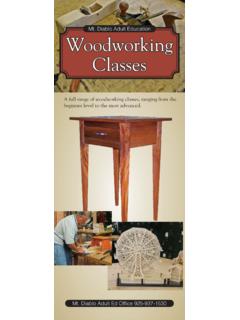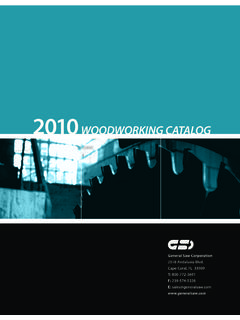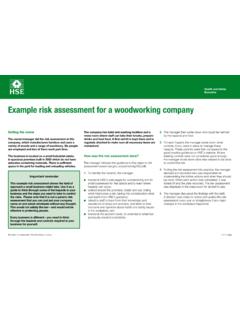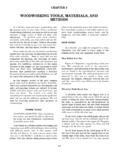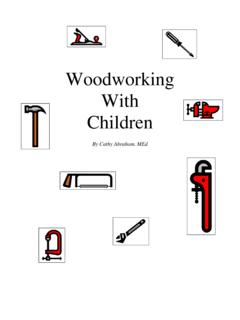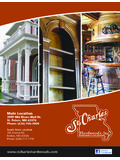Transcription of Reducing noise at woodworking machines WIS13
1 1 of 4 pagesHealth and Safety ExecutiveHealth and Safety ExecutiveWoodworking Information Sheet No 13 (Revision 2)HSE information sheetReducing noise at woodworking machinesIntroductionThis information sheet is aimed at employers in the woodworking industry and gives advice on controlling the risks from noise . It supplements the leaflet INDG362 noise at work: A brief guide to controlling the Further practical advice on noise can be found on the HSE noise website harm noise can causeLoud noise at work can cause hearing damage as well as causing other safety risks such as difficulties with communication and not being able to hear warning signals, or approaching plant or woodworking industry is one of the noisiest working environments.
2 noise levels can vary widely between machines depending on their use. Typical examples of machines with no noise reduction measures are shown in Table 1. Exposure to these levels of noise , even for a short period, can be 1 Typical noise levels at woodworking machines MachineTypical noise data for machines with no noise -reduction measuresNoise level (dB)Beam panel saws and sanding machines97 Boring machines98 Band re-saws, panel planers and vertical spindle moulders100 Portable woodworking tools101 Bench saws and multiple ripsaws102 High-speed routers 103 MachineTypical noise data for machines with no noise -reduction measuresThicknessers 104 Edge banders and multi-cutter moulding machines105 Double-end tenoners107 Table 1 gives details of the potential noise levels produced by various woodworking machines .
3 You can use this information, together with the length of time employees spend working at the machines to establish a likely daily exposure. This will help you to decide on priorities for taking noise control tools are available to help you on HSE s noise website. What is expected of employers?The Control of noise at Work Regulations 2005 requires employers to take action to prevent or reduce risks to health and safety from noise at work. Employees have duties under the Regulations are required to eliminate or reduce the risks to health from noise . This involves eliminating noise at source or, where this is not reasonably practical, Reducing the level so far as reasonably practicable.
4 The Regulations set two exposure action values: a lower exposure action value of 80 decibels (dB) at which workers need to be informed about risks to their hearing and be provided with hearing protectors, if they want them; an upper exposure action value of 85 dB at which noise exposure has to be controlled by doing all that is reasonably practicable other than by hearing protection, for example by making machinery quieter or sound proofing it is not possible to reduce the exposure to below the upper exposure action value after installing noise controls, employees should be provided with 2 of 4 pagesHealth and Safety Executivehearing protection and be trained to use it whenever it is needed and to fit/insert it correctly.
5 Hearing protection zones should also be marked in the areas of the workplace where hearing protection is compulsory for all people entering the zone. Health surveillance is also required where a worker is at further information about the legal requirements visit HSE s noise website: are many practical, cost-effective ways that you can use to control noise and protect workers. For woodworking machinery, noise -control measures are likely to include: using appropriate systems and working practices; using the most appropriate machine for the task; engineering noise -control at source; effective maintenance of equipment, which can have immediate noise -reduction benefits; limiting the time people spend in noisy have duties to use the noise -control equipment provided and to report any defects in controls to reduce noise exposuresEngineering control measures are likely to be necessary to reduce noise , eg: change to quieter tooling; modify dust-extraction systems.
6 Or provide a noise noise from woodworking machinesSome of the factors that can affect noise levels when using woodworking machines are set out in Table 2. You should consider these factors when designing your working practices, aiming to ensure that your employees noise exposure is as low as reasonably practicable. Make supervisors and employees aware of these issues, particularly when Reducing noise exposure depends on following proper systems of work. Training will be required in setting, operating and maintaining equipment for low- noise working and in the correct use of any noise control 2 Factors affecting noise levels when using woodworking machineryVariableRelevant factor EffectTimberSpeciesHard, stiff timbers mean more noise (eg 2 dB difference when cutting oak and pine at a band re-saw) and more noise Wide workpieces radiate noise over a greater area (eg a working width of 200 mm is likely to cause an increase of 2 dB over a working width of 100 mm).
7 Thickness Thinner workpieces generally vibrate more. Planing under 20 mm thicknesses can greatly increase the noise workpieces radiate more noise than short contentDry timber is brittle and a good transmitter of of cut Unless helical or segmental cutters are used, the noise level immediately above the cutter increases roughly in proportion to the width of the cut (eg doubling the cutter length increases the noise by 3 dB).Cutter sharpnessDull knives and worn blades and bands exert more force on the timber therefore make more projectionIncreases in knife projection mean that more air is trapped during rotation and so more noise is produced (typically 2 to 3 dB more for each millimetre projection above mm).
8 Speed noise increases with tool speed (typically just under 1 dB for every m/s change in peripheral speed in the range 20 to 35 m/s).BalanceOut-of-balance tools means vibration and changes in cutting conditions, increasing settingTimber control The freer the timber is to vibrate, the greater the noise level (eg poorly set chip breakers and pressures at multi-cutter moulders lead to more transmitted noise ).Timber support noise is increased if fences, bed plates, chip breakers etc which support the timber close to the cutting circle are not in line and as close as possible to the cutting velocity/system designIn a system with turbulent airflow, wood chips strike the ducting more and, without damping.
9 This can increase noise of 4 pagesHealth and Safety ExecutiveYou should also follow the manufacturer s or supplier s advice to ensure that the installation and operation of woodworking machines results in the lowest noise levels new machineryManufacturers of woodworking machines are legally obliged to design and manufacture them so they produce as little noise in use as possible. Information about the noise produced by a machine should be provided in the manufacturer s instructions. These should also tell you how to operate the machine as quietly as buying new woodworking machinery you should include noise emission in the specification.
10 This will allow you to make informed judgements about the noise risks for particular machines before buying them. You can then identify the machine that will introduce the least noise into your featuresManufacturers and suppliers of woodworking machinery should be able to describe the low- noise features of their machinery. Appropriate design measures vary depending on the machine type, but will in general include: the machine structure being designed to minimise direct noise radiation, eg flexible panels should be avoided or treated; anti-vibration mountings; acoustic absorbents, shields or enclosures for control of unavoidable noise sources; use of advances in cutter design, eg damped or low- noise blades for sawing machines , segmental cutters for moulders and helical cutters for planers; machine tables with slotted lips to reduce noise when air gets trapped between revolving cutters and fixed surfaces.










